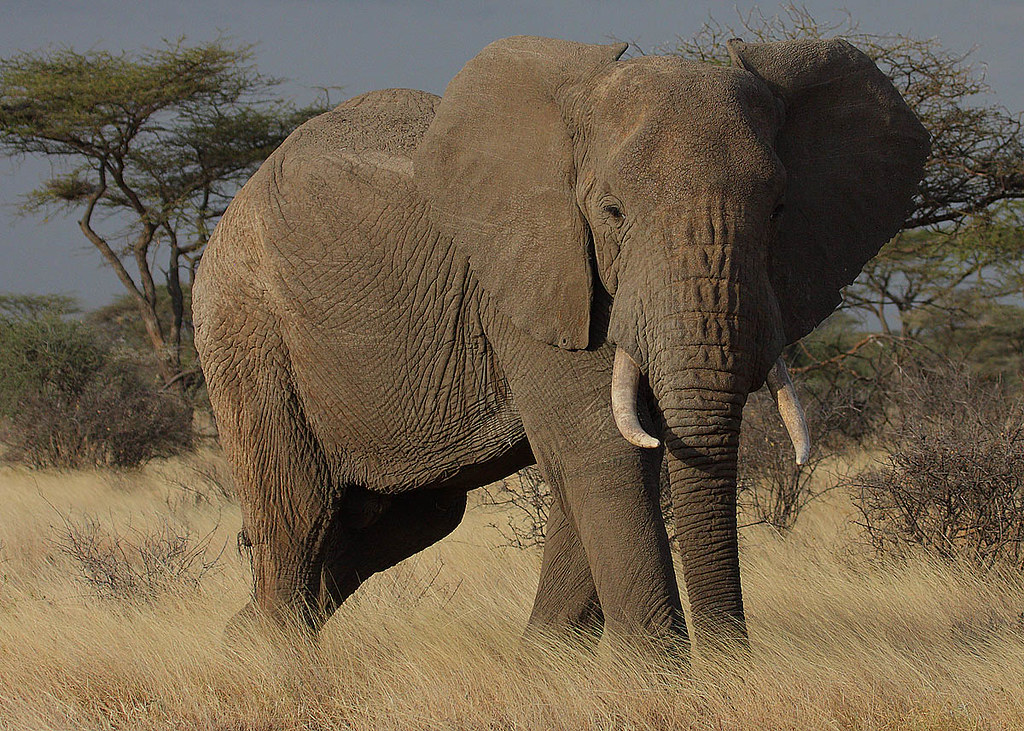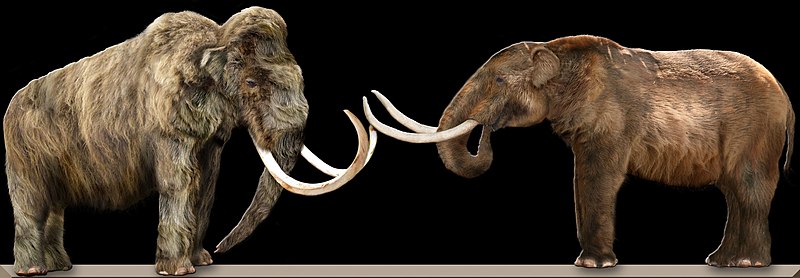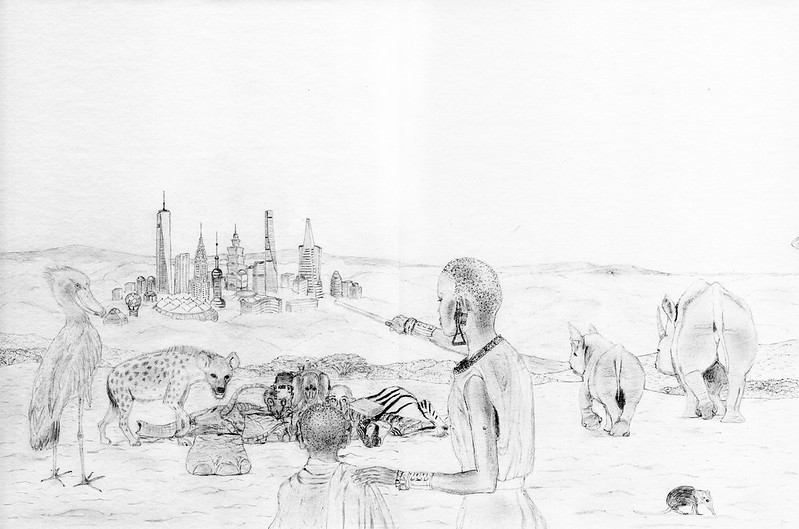Classification:
Order: Proboscidea
Family: Elephantidae
Genus: Loxodonta
Species: L. africana – African Bush Elephant
L. africana cyclotis – African Forest Elephant
Characteristics: The largest land mammal embodies the issues of a globalised illegal trade
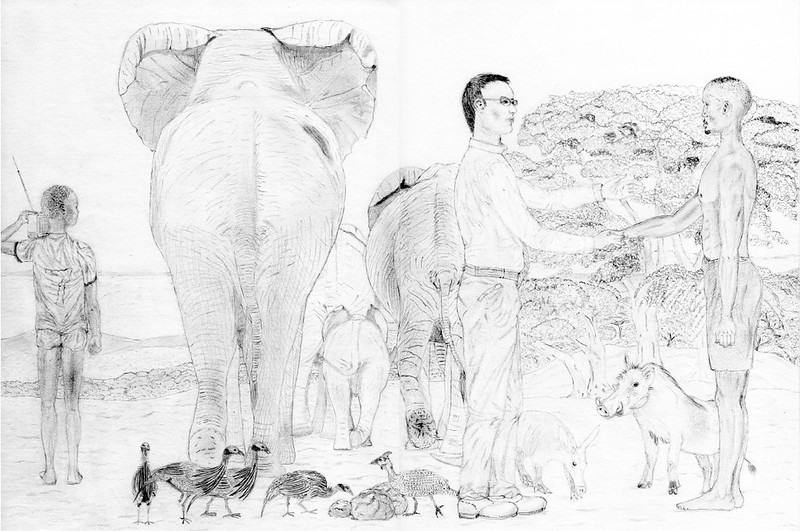
Main Threats:
- Poaching to fuel the ivory trade
- Wars and guerrillas disturbing elephants' habitat and fuelling poaching
- Habitat destruction through large infrastructure projects, deforestation
- Conflict with rural communities and farmers
If there are two animals that come to everybody's mind when mentioning Africa, they certainly are the lion and the elephant. Both animals are today considered as threatened.
Poaching of elephants has been a long standing issue. However, the largest land mammal in the world has come under increased pressure in the last decade. This clearly coincides with the African continent opening more and more to the global economy.
Let it be even clearer: Although ivory trade has been controlled by the CITES (Convention on International Trade in Endangered Species of Wild Fauna and Flora) for several decades now, African elephants are today under a pressure they never experienced before.
There are striking figures:
The Tanzanian Elephant Protection Society stated that elephants numbered 70 000 in 2006, less than 13 000 in 2014 in Tanzania. It is estimated that 30 elephants are killed there daily. At this pace, wild elephants could be extinct in Tanzania by the early 20's.
According to the CITES[1], 2011, an estimated 25 000 elephants were illegally killed in Africa in 2011, the estimated figure is 22 000 in 2012, still over 20 000 in 2013. This means that in a three year time, almost 70 000 elephants were the victims of a large scale illegal trading, with relatively low media exposure! This makes up around 140 000 elephant tusks, a minor part of them having been seized by the customs.
The International Fund for Animal Welfare (IFAW) is even more pessimistic and estimates that an elephant is killed every 15 minutes, that makes up almost 100 elephants a day…
Giant of the Savannah and Giant of the Rainforest…
There are two distinct species of African elephants. Both belong to the same genus Loxodonta, unlike Asian elephants that belong to the distinct genus Elephas.
The African bush elephant is the iconic safari elephant and has the widest range. It can still be found as north as in Mali and its scattered range extends down to South Africa. It was historically present in most sub-Saharan countries where the savannah biotope exists.
It is larger in size than the more elusive African forest elephant. This latter is a smaller, shyer animal and its more modest tusks are straighter, pointing downwards. They dwell in central and western African rainforests where they play an essential role in the seed dispersal of several trees through their dungs.
African forest elephants were long thought to be a mere subspecies of the bush elephant. They are now considered as members of a distinct species because of their distinctive genome.
Who is benefiting from the ivory trade?
Certainly not the elephants…
Based on the large figures of poached elephants and the small amount of ivory seized in comparison, the ivory collected gets its way to its final destination in Asia.
As Sub-Saharan Africa has turned to be a promising player in the global economy for more than a decade now, investments are pouring on the continent. Chinese FDI (Foreign Direct Investments) officially totalled 14.7 billion on a one year period as of mid 2012 on the African continent[2]. The real investments would actually be higher. Since 2009, China has become the top foreign trader in Africa ahead of the USA.
Major infrastructure projects have been launched and are reshaping the face of a whole continent. The latest is the East Africa railway system that will eventually interconnect seven countries[3].
Those infrastructures are aimed at bringing African citizens a better life and better business opportunities. However, they have obvious side-effects. Environmental considerations and biodiversity protection are not taken into account.
Railways, roads, modern port facilities allowing linking African inland to the rest of the world have been built. At the same time, poaching of rhinos and elephants has surged...
Foreign companies control entire parts of the local economies. In particular, Chinese transport companies operate in the major Eastern African ports. These places are strategic bottle-necks to be monitored to fight illegal trading. The question is to know whether African nations want to keep control and whether sufficient means are put in place to allow it.
At the same time, several African countries are struggling with a new generation of poachers. They are now mastering modern equipment and state-of-art weapons. This is a significant change compared to the traditional poaching those nations were used to fight. National armies with limited means are often a technological step behind. Human lives are lost on both sides.
Elephant poaching is so flourishing that it has been pointed out as a factor of political instability in Sub-Saharan countries by several NGO's: Local separatists or religious groups can finance guerrillas with the help of ivory sold on the black market[6].
So, if the ivory trade benefits to Africans, it is only to a handful of them and not for the sake of the continent political stability.
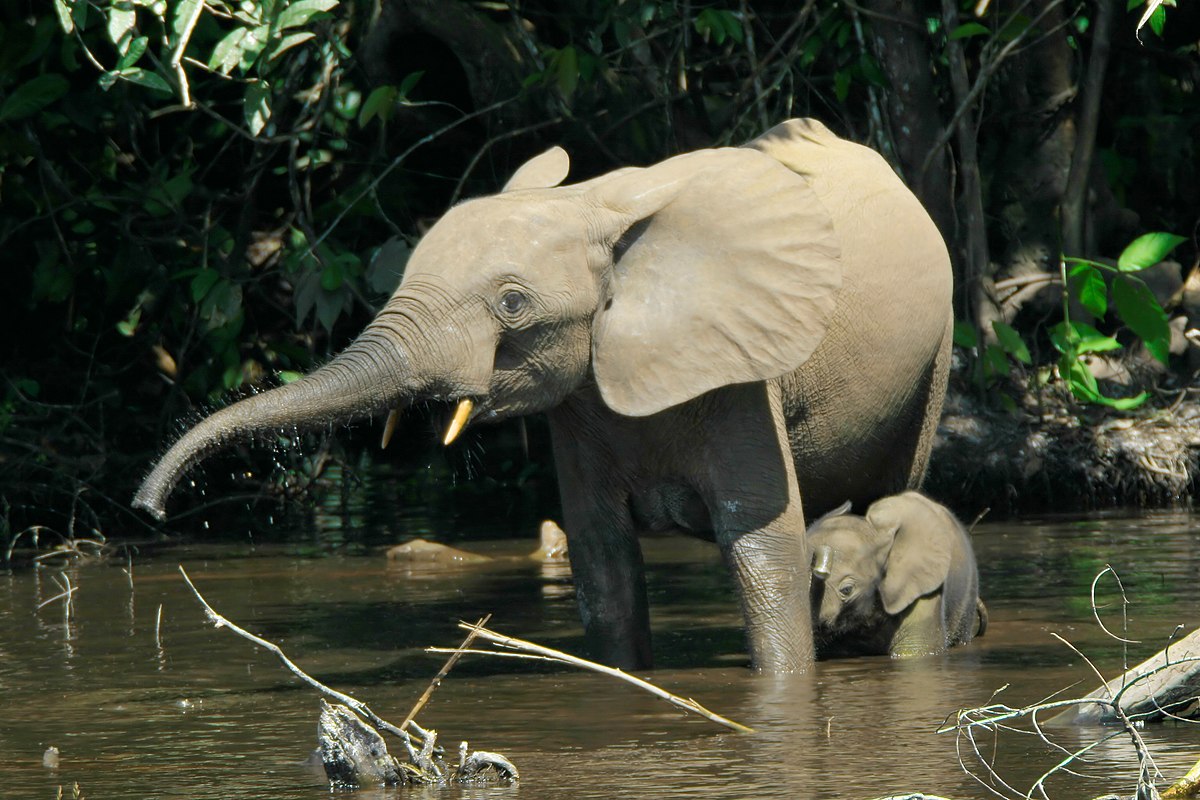
Are seized ivory stockpiles a solution?
As of 2017, legal ivory trade is under strict control of the CITES and is exclusively restricted to identified stockpiles. Important quantities have been seized during anti-poaching campaigns in Africa. Some African countries still holding those stockpiles are regularly advocating for a legal trade of these. There have been several one-off sales authorised by the CITES in the last decades.
In 2008, China was allowed to buy a 62-tonne stockpile of ivory under the auspices of CITES. Instead of decreasing the poaching pressure, this transaction actually stimulted domestic demand with the effect of price increase and massive input of illegal ivory on the Chinese market[5].
As of April 2017, it is estimated that the illegal ivory stockpile in China is around 1000 tonnes, that is around 15 times the legally purchased 62-tonne stockpile of 2008[5].
Until the complete ban on ivory trade is effective, official ivory retailers in China have to comply with ivory traceability. This process aims at proving that each ivory item sold can trace back to a tusk from legal stockpiles. However, this system is far from being sufficient.
BBC investigation journalists in Hongkong could easily detect massive frauds concerning ivory traceability in such ivory retailer outlets, mainly due to loose controls by authorithies[6].
It is also deemed that current poaching figures are well above the ivory flow put on the market in East Asia. In other words, illegal stockpiles have increased to artificially keep prices up.
Fighting the illegal Trade
Detailed investigations have identified the functionning of the ivory trade from supply areas to end-markets in Asia.
According to the thorough report of C4ADS published in May 2015[7], it is estimated that 50 to 75% of the total ivory transits in fewer than 250 containers, using less than 25 ports in Africa and Asia. It is also estimated that this bulk of ivory reaches their end-market with the involvement of less than 15 major shipping companies and 5 pre-shipment companies.
This global illicit business is therefore dependant on a relatively low number of actors.
However, the report[7] also points out that there has been an increase in alternative transports (smaller airfreight and courier activity) during the 2014-2015 period.
Precisely understanding the networks, transit points and financial flow of this business can help fighting it more efficiently. However, it implies tougher controls and eradication of corruption and bribery in the transit bottlenecks (ports, airports, customs...).
This report also points to the mechanisms/networks involved regarding the financial transactions between sellers and end-market retailers: They often overlap with those used for drug trafficking money laundring[7].
Changing the Customs – Saying No to Elephant Ivory
Alternatives to elephant ivory exists: As of August 2017, it is still legal to trade mammoth ivory, including in China.Russia has specialized in exporting mammoth tusks to ivory end-markets . However, the yellowish colour of the tusks makes them less attractive than elephant ivory to buyers.
Still, there are signs that mentalities are changing in countries where demand for ivory subsides.
Mainland Chinese citizens feel more and more concerned about Environment and Biodiversity issues.Some prominent media figures have publicly advocated in favour of elephants, as Chinese actress Li Bing Bing 李冰冰[8].
NGO WildAid conducted an insightful survey concerning the perception of Chinese citizens on the issue of ivory trade[9]. 961 residents of Beijing, Shanghai and Guangzhou were interviewed in 2012. On one hand, only a third of them thought ivory sold would come from poached elephants. On the other hand, 99.2% of these residents agreed "that we should ensure that elephants exist on Earth".
These results show that Chinese citizens are in need of a better awareness of the illegal ivory business and could potentially change their consuming practice if they realize the killing of elephants to feed the ivory market is not sustainable.
In 2012, the International Fund for Animal Welfare, IFAW China launched a campaign for more sensitisation on illegal trade of endangered species[9]. This included awareness messages printed in airports, railway stations, post offices and customs offices all over the country. This campaign received a positive feedback from the general public, especially among young people and students. IFAW China had several significant achievements, including the forbidding of websites advertising elephant ivory, rhinoceros horns and other endangered species products. However, the fight needs to go on as the demand remains strong.
Time left to act is counted now…Countries that are the destination markets need to do more than just good-will statements and occasional ivory seizures. They need to take their responsibility and play transparency in the whole logistics that allows this illegal business to thrive. They need most of all to educate people.
2017 Chinese Ban on Ivory Trade: A decisive Turn?
China officials triggered worlwide attention end of 2016 at the CITES with the announcement that they would ban ivory trade in PRC end of 2017[5].
This drastic change regarding the ivory trade issue is seen as a significant step in favour of African elephants conservation.
Some analysts invoke China's will to secure their diplomatic ties with their African partners rather than a genuine will to protect elephants, as the ivory illegal trade has become a source of diplomatic embarrassment.
On the 31st of March, 2017, the Chinese government imposed the closure of half of licensed ivory factories and shops. The other half should be closed before year's end[11].
The effective control of this ban and the means put in place to prevent a flourishing ivory black market to replace licenced businesses will be challenges for the years to come.
An official ban alone will not bear fruit if Chinese citizens are not given awareness that consuming ivory should become a custom of the past.
Why elephants are so important:
From an evolution point of view, elephants are the only descendants of the Elephantidae family and as such have a very unique value in the global biodiversity. It is estimated that this family appeared some 7 million years ago in Africa. Its members then dispersed to Eurasia and to the North American continent through the Bering Strait. Outside Africa, the Asian elephant is the only living descendant of this family as all other species went extinct.
The extinction of the woolly mammoth is very recent: scientific studies have shown that it only occurred 4000-4500 years ago. This iconic ice age mammal was part of the diet of Homo sapiens. It survived in a remnant population on Wrangle Island, an island in the East Siberian Sea until 2500-2000BC. The Asian elephant is its closest surviving relative [10].
Another large prehistoric mammal, the mastodon was part of a distinct family that does not have any representative today.
From an ecological point of view, elephants are essential actors of the biotopes in which they dwell. Bush elephants and forest elephants alike have access to supplies of food that are not within the reach of other species. As the digestion process of elephants is only partial, several species of birds and insects feed on their dungs. Seeds that survive elephant digestion and that are not eaten by other species will eventually disperse in nature and contribute to the renewal of the savannah and rainforest vegetations: The landscapes of these biotopes are therefore intimately linked to the presence of elephants.
Many species of trees have evolved to use seed dispersion by elephants, to the point that for some of them, seeds can only germinate when they have been through the digestion tract of the mammal.
From a cultural point of view, elephants and mammoths have been represented by humans for thousands of years. Elephants were almost mythical creatures in Antiquity and during the Middle-Ages in Europe.
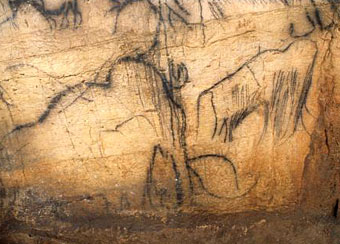
In Western Europe, a famous historical event is associated with elephants. Carthaginian military commander Hannibal Barca used war elephants during his campaign against Rome around 218-217BC. An estimated three dozen elephants crossed the Pyrenees mountains in Southwest Europe to get from Iberia to Gaul on the way to Rome, contributing to Hannibal's success because of their frightful appearance.
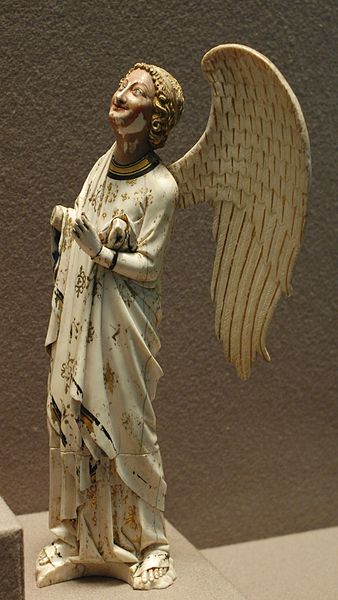
13th century, Musée du Louvres as exhange-deposit from the Museum of Chambéry
- Photo by Jastrow
In Asia, the traditional ivory carving is a centuries old tradition. There are archaeological evidences that China traded with Eastern Africa in order to import ivory back in the middle-ages (Indian Ocean Trade). However, with modern weapons, logistics and a much greater demand, ivory trade between China and Africa is now an illegal business that is threatening the very existence of the elephants in the wild.
Similarly to Asia, ivory has also been used until the 20th century in the western world. Religious items as well as jewels and refined ornaments were made of precious goods: gold, silver and elephant ivory were some of them.
The Western World's demand for ivory was the major driving force for elephants killing until the early 1960's[5]. Following the boom of Japanese economic economy in the 70's and 80's, Japan also became a significant market for ivory.

– Photo by Siren-Com
Until the 80's, piano manufacturers were the main buyers as ivory was used to make keyboards. With the CITES listing elephants as threatened species, laws were progressively put in place so that elephant ivory would no more be used. Substitutes such as synthetic ivory or mammoth ivory have been used since then.
What can I do as a simple citizen?
As one of the last remaining representative of the Earth megafauna, elephants are a unique heritage that shall be passed to the future generations.
Owning ivory items that have been passed from generation to generation in families is of course totally legal. Be simply aware that when putting some ivory items on sale on the internet, you are also unintentionally promoting the laundering of illegal ivory on websites that do not have strict traceability policies.
To give elephants a chance, we should:
- Never buy any product made of elephant ivory, body parts or organs, whether it be a decorative item, a ritual item or a medicine
- Support programs aimed at protecting the remaining elephants habitats
- Report any illegal ivory trade to your local fraud prevention bureau
- Report any suspect ivory trade you could identify on the internet
- Minimize or avoid the consumption of products that are conflicting with elephant's natural habitat, if possible select products that are produced according to a chart of environmental responsibility. Exotic wood in particular are playing a role in the disappearance of African forest elephants in Central Africa. Palm oil is also using more and more space gained to the rainforest in countries such as Sierra Leone.
- And if you can afford it, support ecotourism and give your children the chance to see those wonderful animals in the wild. This includes ecotourism in countries such as Kenya, Tanzania, Zambia, Namibia and South Africa to spot the African bush elephants. It is much more difficult to spot the elusive African forest elephants but countries such as Gabon and Congo have agencies specialized in discovering the fauna of their magnificent rainforests
If you feel particularly concerned by the fate of elephants, you can donate to foundations involved in their protection, speak out about the threats that they are facing to your friends, and advocate for a stricter control of ivory trade in your country and with your trade partners.
[7]Jackson Miller, Varun Vira, Mary Untermohlen (May 2015) - Species of Crime, Typologies and Risk Metrics for Wildlife Trafficking

